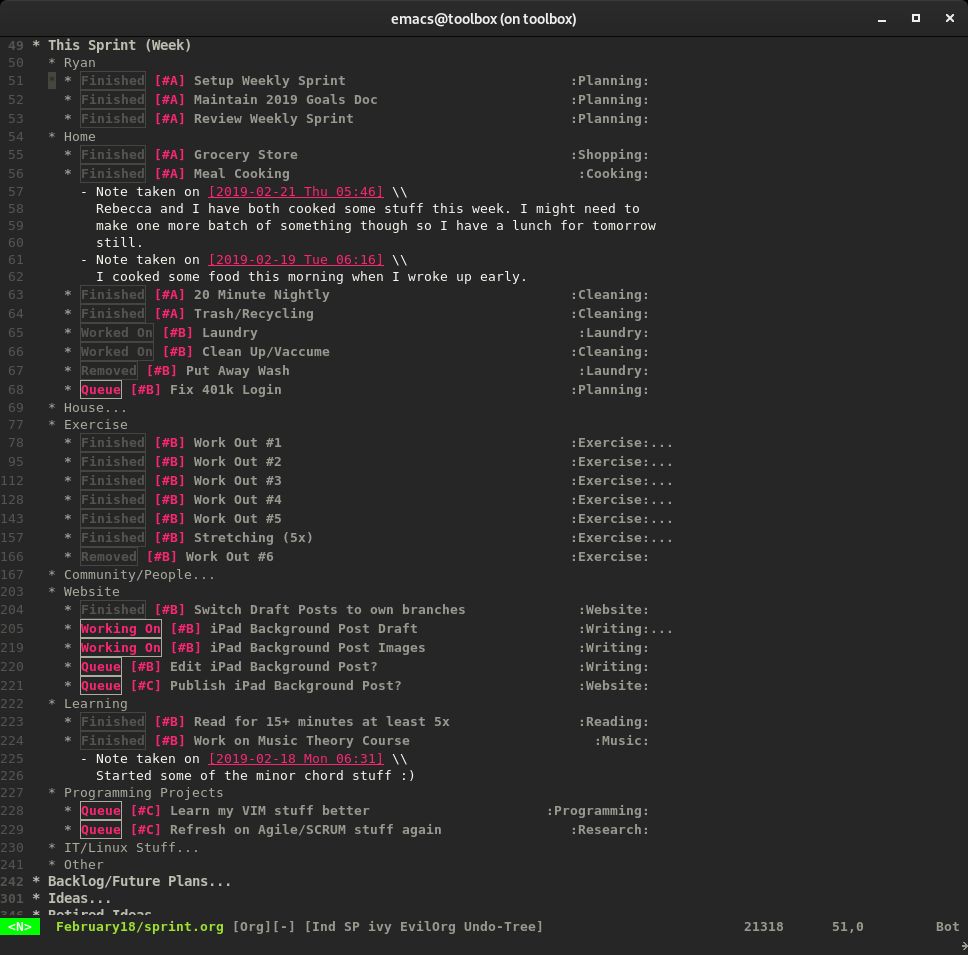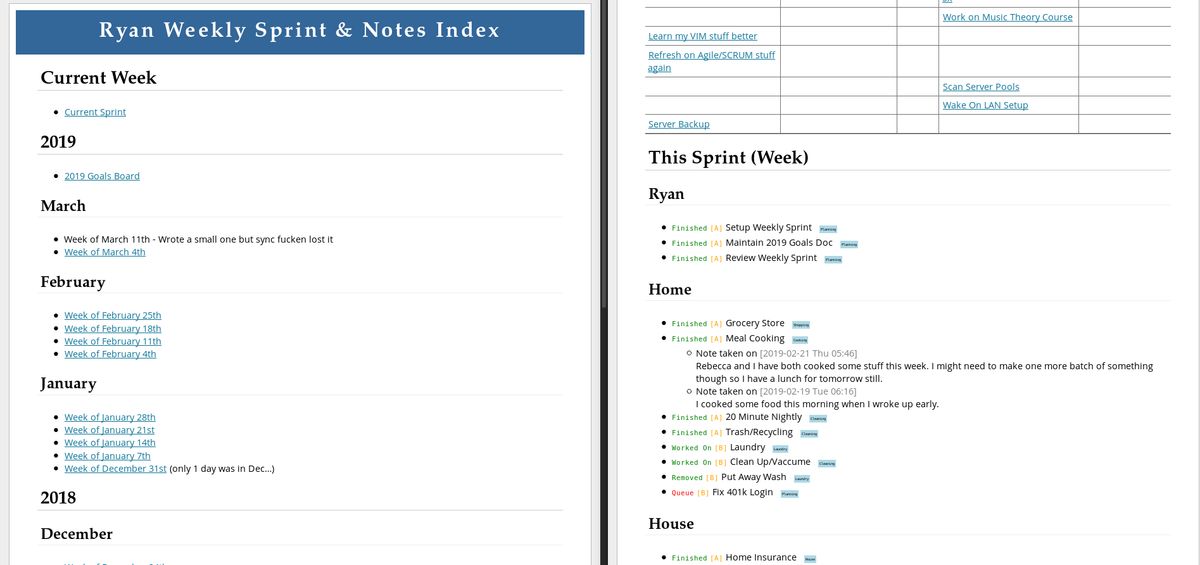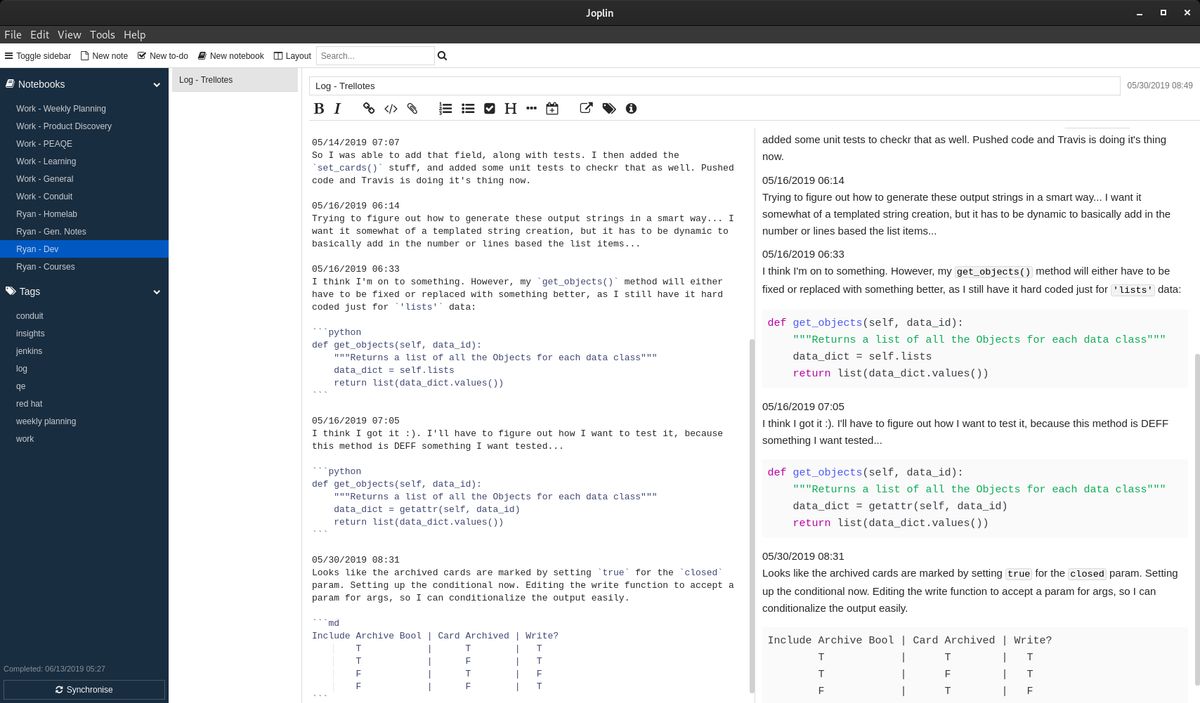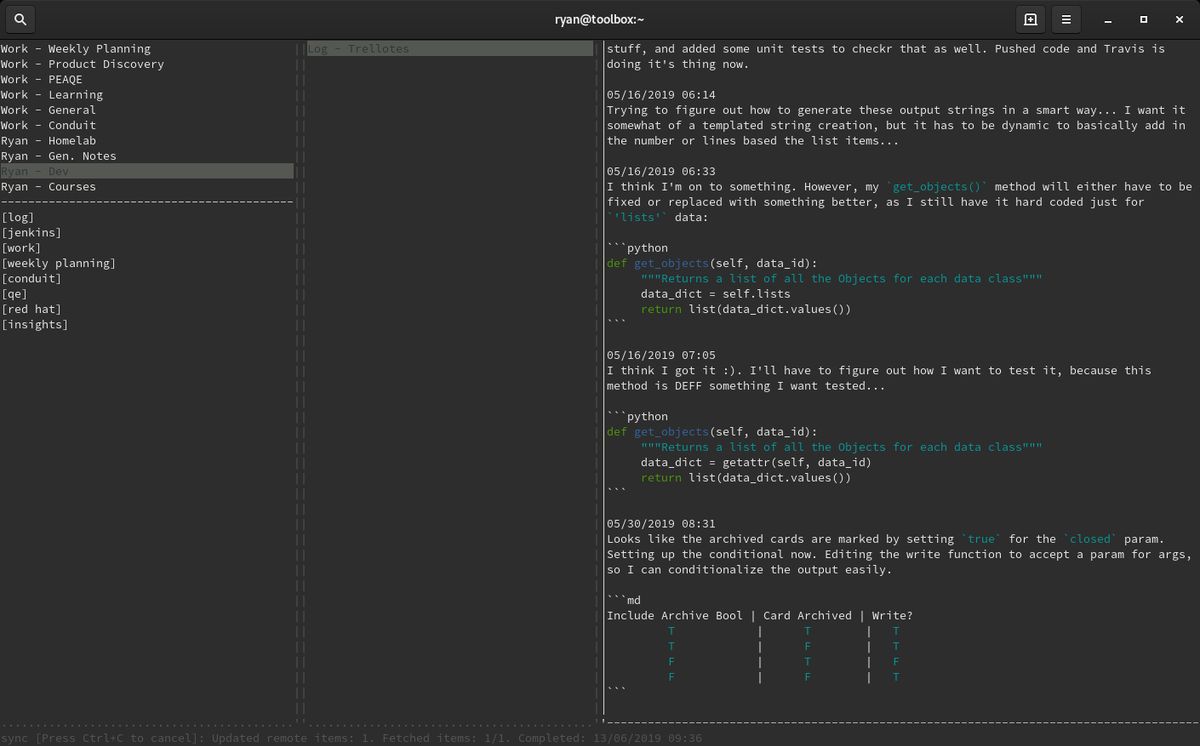Switched to Joplin Notes

As a massive fan of emacs’s
org-mode, it should be no surprise that I’ve been using
it for my personal and work planning/notes over the last few years. However,
as my daily emacs usage has slowly dropped, and the support for .org files
outside of emacs remains low (other than Github README
files), I started
to look for a more standard system. The last few months, I’ve been using
Joplin. Here are my thoughts.
Previous System - Org-mode

Previously, I had been taking all of my notes using org-mode in emacs. Each
week, I made a new .org file for my work notes, and another for my personal
planning/notes. I would then list my todo
items, usually grouped by day,
category, or both. I would also
tag each item, for better organization.
As I worked on each task, I could quickly add time-stamped notes using the
built-in logbook drawer shortcut. In
these notes, I would ramble, or paste a code snippet to save for later. As work
on each item progressed, I could set the TODO status to Working On
Finished, Removed, or any other state I had pre-defined. Eventually, I
wrote an emacs-lisp
script/package that took the
todo items in my org file, and dumped them into a SCRUM board at the top of
the file.

Lastly, org files can be exported
to all sorts of file types (md, html, pdf, latex). By combining the export
feature with internal
linking, I was able to create
an organized system for my archived notes. I created an index.org file which
linked to each week’s notes. Every week, I would archive the html export of a
note, and add it to the index list. This meant I could browse my old notes as a
website.
What I liked
org-modeis great.- I could take all of my notes in a simple markdown language (org)
- Good code-block support
- Note linking
- Exported to html (or txt, md, pdf, or anything really)
- My previous notes were all exported to an archive website
Issues
- I had to use emacs for any edits
- Not supported on mobile devices
- As I used more
.mdsyntax for other applications, I found myself fumbling betweenorgandmdsyntax often. - Syncing issues (mostly Nextcloud issues. Seafile helped, but it still occurred)
All in all, I loved taking notes in org-mode. However, I wanted something that could be used on all my devices, and was more easily translatable outside of “emacsOS”.
The Switch - Joplin

About Joplin
Joplin is an open source note-taking and to-do application. It synchronizes and organizes markdown notes into notebooks, across many platforms (Android, iOS, macOS, Linux, and Windows). It even has both a GUI and terminal client. So, I decided to give it a try.
My Setup
When configuring joplin, a sync system has to be defined (well, should. Notes can also be saved locally). There are a few supported options including using Nextcloud. I had previously synced my org notes using Nextcloud, but eventually moved away from it due to repeated file conflict issues. So I wanted to try something different.

While researching Joplin, I learned that I could sync notes to the WebDav server on the fastmail account I have for email. I wasn’t using any of the account’s file storage, so I figured I this would be a good way to get use out of a service I’m already paying for. It works great!
What I like
Syncs on all my devices
What I have enjoyed most about this setup is that my notes sync to all of my devices. Most importantly, I can read the notes on every device. With previous systems, the files would sync everywhere, but I still couldn’t always easily read them.
CLI and GUI versions
Similarly, I like that Joplin has both a GUI and CLI client. I mostly use the GUI, but enjoy having the CLI as an option because it means I can always ssh into a machine and take notes. Additionally, the cli client allows me to take/edit notes using my own terminal editors such as emacs or vim. This is quite convenient, and I should probably start using Joplin this way more often.
Markdown Note Exports

I like that notes are formatted in markdown. This provides some
consistency when writing, but ensures that my notes are in a format that is
standardized. Additionally, joplin allows easy exporting of
the notes to other formats such as json or as pdfs.
Easy enough to use
Lastly, Joplin has been easy to use. After setup, I just have to open the app, and start typing away (maybe with a sync or two). While my last setup required the user to be somewhat of an emacs/org guru… this doesn’t.
Issues I’m still figuring out/Anticipate

Setup is a pain
While configuring sync can be a pain, it’s not my biggest gripe with the Joplin setup process. It’s adding a new system. By default, if I configure a new device with my sync solution (my laptop or phone for example) and then sync, it will load up all of the crap default example tags and notes, which then pull down to all of my systems. This is extremely frustrating because I have to keep deleting them. This is multiplied by the fact that it happens with each client I setup. So if I setup the gui and cli on my laptop, it will happen twice (2x each default tags/notes will show up on all my systems).
Semi-Solution:
A slight work-around I have been able to use when setting up a new computer
is to simply copy the config files from an existing system to the new one.
These folders can be found at ~/.config/joplin/, ~/.config/Joplin/, and/or
~/.config/joplin-desktop/. This also means that the new system should have less
it needs to sync down from the server on the first sync.
Long term archiving
The big problem I have… and think I will continue to have with Joplin, is the long-term organization of notes. Part of this is my inability to figure out an efficient and organized way to handle my “log” notes.
This problem partially stems from Joplin’s shallow organizational
structure. There are notebooks, and notes. That’s it. Unlike having
a file structure where I can do something like
archive/2019/June/Weekly_Plans/, I can’t really go that deep with Joplin, so
I end up just having a single notebook with all my weekly plan notes listed
in it.
One remaining solution might be to get more aggressive with the tagging feature, and see if I can create a more organized system using that. I might be able to tag each note with a month/year, and then truncate my log notes each month. The only problem with this is that it doesn’t seem like I can select multiple tags at a time, which would mean all of my notes for a month will be shown under the tag. That would be a deal breaker for me :( .
Conclusion
In summary, I think that Joplin is a great open source notes solution. If someone needs a system to keep a bunch of normal notes synced across all their devices, this is it. I however, might need to try out something else long-term. On the bright side, there are a bunch of features in Joplin that love and will definitely look for… in my next solution.